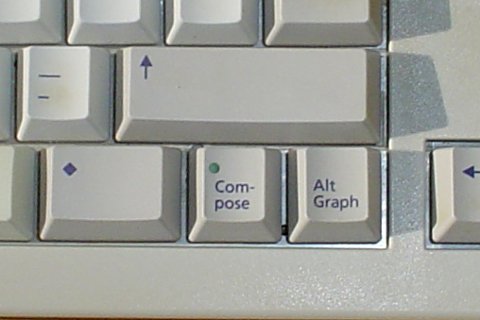Compose key
This article is a stub. You can help Deskthority by expanding it.
| Names | Compose, Compose Character |
|---|---|
| ISO/IEC symbol |
⎄ |
| X11 | Multi_key (keycode 135) |
| USB | Keyboard Application (7:0x65) |
The Compose key or Compose Character key is a dead key used for "composing" special characters by combining existing ones found on the keyboard.
It sometimes has a lamp that tells when the keyboard is in Compose mode.
Usage
The Compose key is first pressed, followed by the key sequence for the character. The keys are usually two.
For example Compose, A, E pressed in sequence produces the ligature Æ.
Keyboards
The key was common on terminal keyboards such as the DEC LK201 and on Unix keyboards such as the Sun Type 5.
In the USB HID standard, it has the same code (7:0x65 "Keyboard Application") as the Menu key but it does have a dedicated LED (8:0x04 "Compose"). USB Sun Type 6 and Sun Type 7 have this mapping.
To enable
Gnome 2 / Mate
In the menu select System→Preferences→Hardware→Keyboard.
Then select the Layouts tab and click 'Options...
Then click 'Position of Compose key and choose which key that should be the Compose key.
MS Windows
A third-party utility has to be used:
- WinCompose
- AllChars
- MrBertie's compose-keys
- p3lim's Compose
- Solution for KbdEdit
External links
- COMM UTF-8 (Unicode) compose sequence — Compose-key sequences supported by Xorg.
- Compose key on Wikipedia.
